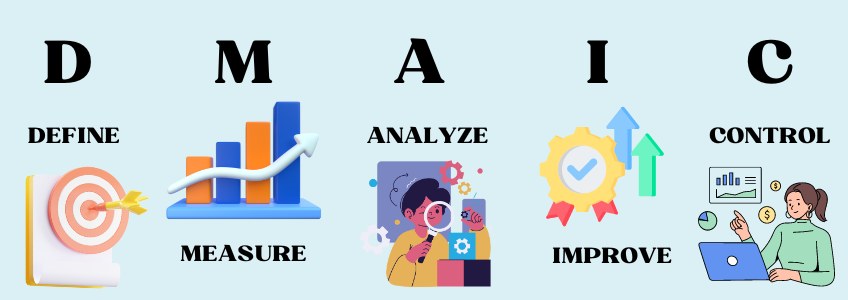
In the world of continuous improvement, the Six Sigma DMAIC methodology stands out as a powerful tool for problem-solving and process optimization.
|| 10 minutes read ||
Overview of the problem and the approach taken
In this blog, we delve into how a team of professionals tackled a daunting $65 million issue using DMAIC – Define, Measure, Analyze, Improve and Control. By leveraging tools such as Pareto analysis, fishbone diagrams, 5 Whys, Gemba walks, and SCAMPER brainstorming sessions, the team was able to identify root causes, generate innovative solutions, and implement sustainable changes.
Join us on this step-by-step guide to see how DMAIC, combined with teamwork and strategic planning, can lead to successful problem resolution and long-term results.
1. Define: Identifying the problem and setting goals
In the Define phase of DMAIC, the first crucial step is to identify the problem at hand. By defining the problem statement and setting specific, measurable, achievable, relevant, and time-bound (SMART) goals, the team can align their efforts toward a common objective. It is essential to gather relevant data, engage stakeholders, and establish a baseline for current performance.
Through effective communication and collaboration, the team can ensure everyone is on the same page regarding the issue and the desired outcome.
Stay tuned to learn, how a well-defined problem statement lays the foundation for the success of the DMAIC process.
2. Measure: Collecting data and analyzing the current state
In the Measure phase of DMAIC, the focus shifts to collecting relevant data and analyzing the current state of affairs. This step involves identifying key metrics, establishing data collection methods, and ensuring data accuracy and reliability. By analyzing the gathered information, the team can gain valuable insights into the root causes of the problem and quantify the extent of the issue. Through rigorous data analysis and interpretation, the team can uncover patterns and trends that will guide future improvement efforts.
Stay tuned to discover how data-driven decision-making plays a crucial role in solving the 65-million-dollar problem using the DMAIC methodology.
3. Analyze: Identifying root causes and potential solutions
In the Analyze phase of DMAIC, the focus shifts towards identifying the root causes of the problem and exploring potential solutions. This stage involves conducting a thorough analysis of the collected data to pinpoint underlying issues that contribute to the $65 million problem. By utilizing various tools and techniques such as root cause analysis, fishbone diagrams, and statistical analysis, the team can delve deeper into the factors influencing the problem.
Through this meticulous process, the team can gain a comprehensive understanding of the issues at hand, paving the way for informed decision-making and targeted action plans.
Stay tuned to uncover, how the Analyze phase propels us closer to resolving the multi-million-dollar challenge.
4. Improve: Implementing changes and measuring results
In the Improve phase of DMAIC, the focus is on implementing solutions identified during the Analyze phase to address the root causes of the $65 million problem.
This stage involves developing and executing action plans aimed at improving processes and eliminating inefficiencies. By carefully monitoring and measuring the outcomes of these changes, the team can determine their effectiveness in tackling the problem. Continuous evaluation and adjustment of strategies are key elements of this phase to ensure sustainable improvements.
Stay engaged as we dive into how the Improve phase plays a pivotal role in transforming our approach to resolving this high-stakes challenge.
5. Control: Monitoring progress and sustaining improvements
In the final phase of DMAIC, Control, the emphasis shifts towards monitoring the progress of implemented solutions to ensure sustained improvements in addressing the $65 million problem. This stage involves establishing control measures and mechanisms to track key performance indicators and verify that the desired outcomes are being achieved consistently.
By setting up regular reviews and audits, the team can identify any deviations or issues early on, enabling prompt corrective action. Maintaining open communication channels and documenting procedures are essential in upholding the gains achieved during the Improve phase.
Join us as we explore how effective control measures solidify the success of DMAIC in resolving complex challenges.
Results and Lessons learned from using DMAIC

After implementing DMAIC in addressing the $65 million problem, the results were profound. By following the structured approach of Define, Measure, Analyze, Improve, and Control, the team successfully identified root causes, developed effective solutions, and ensured sustained improvements. The financial impact of saving $65 million is significant, showcasing the power of DMAIC in problem-solving.
Key lessons learned from this case study include the importance of data-driven decision-making, collaboration among team members from diverse backgrounds, and the value of maintaining a systematic and structured approach throughout the problem-solving process.
Stay tuned to gain further insights into how DMAIC can be leveraged to overcome complex challenges effectively.
Conclusion and final thoughts
In conclusion, the case study highlighting the successful resolution of a $65 million problem through DMAIC reinforces the effectiveness of this structured problem-solving methodology. The disciplined approach of Define, Measure, Analyze, Improve, and Control proved invaluable in achieving significant cost savings and sustainable improvements. Emphasizing data-driven decision-making, cross-functional collaboration, and systematic problem-solving methods were key takeaways.
As organizations face increasingly complex challenges, leveraging DMAIC can provide a systematic framework for driving positive change and delivering tangible results. By adhering to the principles of DMAIC, businesses can enhance their problem-solving capabilities and achieve long-term success.
If you are interested to achieve similar success stories, write to us!
